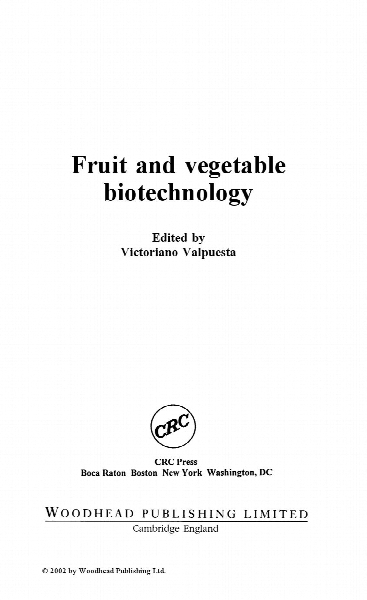Fruit and vegetable biotechnology
- نوع فایل : کتاب
- زبان : انگلیسی
- مؤلف : Victoriano Valpuesta
- ناشر : Boca Raton, Fla. : CRC Press ; Cambridge, England : Woodhead Pub
- چاپ و سال / کشور: 2002
- شابک / ISBN : 9781591243489.
Description
Contributors 1 Introduction V. Valpuesta, Universidad de Ma´laga 2 Tools of genetic engineering in plants J. Pozueta-Romero, Universidad Pu´blica de Navarra 2.1 Introduction 2.2 Selection and isolation of genes 2.3 Transformation and regeneration of plants 2.4 Stability of the transgenes 2.5 Environmental risk assessment 2.6 Future trends 2.7 Sources of further information and advice 2.8 References Part I Targets for transformation 3 Genetic modification of agronomic traits in fruit crops L. Baldoni and E. Rugini, IR Miglioramento Genetico Piante Foraggere CNR, Perugia 3.1 Introduction 3.2 Somaclonal variation 3.3 Gene transformation 3.4 Genetic Stability 3.5 Plant development and reproduction Contents © 2002 by Woodhead Publishing Ltd. 3.6 Fruit quality 3.7 Biotic stress 3.8 Abiotic stress resistance 3.9 Plant breeding: the use of molecular markers 3.10 Future perspectives 3.11 Abbreviations used in this chapter 3.12 References and further reading 4 Genes involved in plant defence mechanisms M. A. Gomez-Lim, CINVESTAV-Irapuato 4.1 Introduction 4.2 Mechanisms of plant response to pathogens 4.3 Genes in the defence against virus 4.4 Genes in the defence against fungi 4.5 Genes in the defence against insects and nematodes 4.6 Long-term impact of genetically modified plants in their response to pathogens 4.7 Future trends 4.8 Sources of further information and advice 4.9 References 5 Genes selected for their role in modifying post-harvest life J. R. Botella, University of Queensland, Brisbane 5.1 Introduction 5.2 Biotechnological control of fruit ripening and post-harvest diseases 5.3 Biotechnological control of vegetable ripening and postharvest diseases 5.4 Future trends 5.5 Sources of further information 5.6 References 6 The use of molecular genetics to improve food properties I. Amaya, M. A. Botella and V. Valpuesta, Universidad de Ma´laga 6.1 Introduction 6.2 Changing the nutritional value of foods 6.3 Modification of fruit colour and sweetness 6.4 Modification of food-processing properties of fruit 6.5 Molecular farming and therapeutic food 6.6 Future trends 6.7 Sources of further information and advice 6.8 References © 2002 by Woodhead Publishing Ltd. 7 Nutritional enhancement of plant foods D. G. Lindsay, CEBAS-CSIC, Murcia 7.1 Introduction 7.2 The nutritional importance of plants 7.3 Strategies for nutritional enhancement 7.4 The priorities for nutritional enhancement 7.5 Relationship of structure to nutritional quality (bioavailabilty) 7.6 Nutritional enhancement versus food fortification 7.7 Constraints on innovation 7.8 Future trends 7.9 Further information 7.10 References Part II Case studies 8 Tomato A. L. T. Powell and A. B. Bennett, University of California, Davis 8.1 Introduction 8.2 Modifications targeting fruit 8.3 Modifications targeting seeds and germination 8.4 Modifications targeting biotic and abiotic stress tolerance 8.5 Modifications targeting vegetative tissues and flowers 8.6 Expression of novel proteins in tomato 8.7 Regulation of transgenic gene expression in tomato 8.8 Conclusions 8.9 References 9 Commercial developments with transgenic potato H. V. Davies, Scottish Crop Research Institute, Dundee 9.1 Markets and challenges 9.2 Potato breeding and a role for GM technology 9.3 Commercial applications of GM potato crops 9.4 Current and future potential for GM potato 9.5 Revised legislation on GM crops in Europe 9.6 The future 9.7 Additional reading 9.8 Acknowledgements 9.9 References 10 Cucurbits, pepper, eggplant, legumes and other vegetables A. Bernadac, A. Latche´, J.-P. Roustan, M. Bouzayen and J.-C. Pech, Ecole nationale Supe´rieure Agronomique de Toulouse (INP-ENSAT/INRA) 10.1 Introduction 10.2 Biotechnology of cucurbits 10.3 Biotechnology of pepper © 2002 by Woodhead Publishing Ltd. 10.4 Biotechnology of eggplant 10.5 Biotechnology of legumes 10.6 Biotechnology of bulky organs (carrots, sweet potatoes, allium species) 10.7 Biotechnology of leafy vegetables (cabbage, broccoli, cauliflower, lettuce, spinach) and asparagus 10.8 Conclusions and future trends 10.9 Acknowledegments 10.10 References Part III Consumer’s attitudes and risk assessment 11 Consumer’s attitudes L. J. Frewer, Institute of Food Research, Norwich 11.1 Plant biotechnology and public attitudes 11.2 What is meant by the term ‘attitude’? 11.3 Changes in attitudes 11.4 Risk perception and impact on attitudes 11.5 Case study: impact of media reporting on public attitudes towards genetically modified foods 11.6 Communication about genetically modified foods and models of attitude change 11.7 Approaches to communication 11.8 ‘Democratic’ approaches 11.9 Fruit and vegetable biotechnology – consumer issues for the future 11.10 Functional foods and consumer issues – implications for fruit and vegetable biotechnology 11.11 Conclusions 11.12 References 12 Risk assessment W. Cooper, formerly National Institute of Agricultural Botany, Cambridge; and J. B. Sweet, National Institute of Agricultural Botany, Cambridge 12.1 Introduction 12.2 Risk assessment and avoidance: general principles 12.3 Assessing the impact of genetically modified crops 12.4 References


